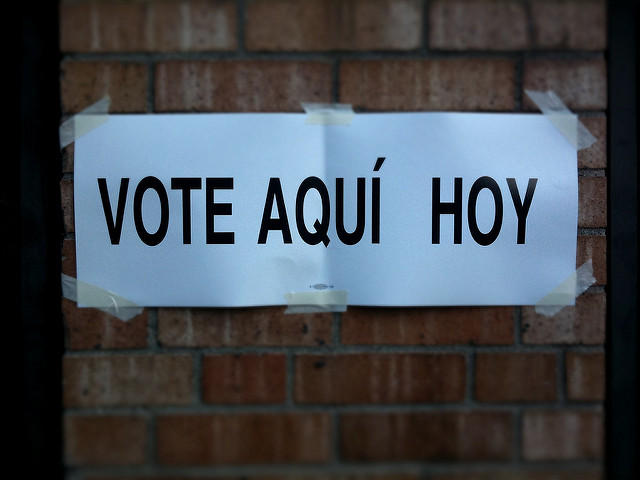When the presidential campaign began, few expected the race to look quite the way it does, with Donald Trump leading the Republican field and Bernie Sanders giving Hillary Clinton a serious challenge.
The next major round of primaries is slated for March 15, when Marco Rubio hopes to vindicate his run with a win in Florida, and John Kasich looks to take Ohio.
But for either party to win the general election, it will have to appeal to Hispanic voters. And so far, the biggest testing ground for that electorate has been Texas, which voted in Super Tuesday.
As the Hispanic population in the country ages, the number of eligible Hispanic voters is expected to hit 27.3 million in this year’s election, according to the Pew Research Center, up from 19.5 million in 2008. Experts estimate the winning presidential candidate will need at least 35 percent of the Hispanic vote in key states.
Though Texas is solidly red in general elections, its primaries allowed candidates on both sides to test the waters of a diverse state electorate. Ted Cruz benefitted from a home court advantage here, but analysts say the dynamic of the state’s Hispanic voters underscores a divide between the two parties, which could prove challenging to overcome for any of the Republican candidates.
About 28 percent of Democratic voters who turned out for the primary were Hispanic, according to exit polls. Hillary Clinton won most of that support, winning 67 percent of the Democratic Hispanic vote.
But just 10 percent of Republican voters were Hispanic. Cruz, who has criticized his other fellow Latino challenger Marco Rubio for his role in immigration reform legislation, led among those voters, with 32 percent of the Republican Hispanic vote. That split, in a state with roughly 5 million eligible Hispanic voters, according to the Pew Research Center, doesn’t bode well for the Republican party come November.
Conventional wisdom says candidates must take roughly 35 percent of the Hispanic vote in the general election to win, says Stephen Klineberg, founding director of Rice University’s Kinder Institute for Urban Research. Faced with a choice to energize the base with anti-immigrant rhetoric or appeal to the growing numbers of Hispanic voters, the Republican candidates – so far – are choosing to appeal to their base, Klineberg said.
“Republicans ultimately cannot win if they don’t get some important minority of the Latino vote,” Klineberg said. “Getting to that number could be tough. The rhetoric has just totally alienated the Latino voter.”
“You would think we have Cruz and we have Rubio, how come they are not appealing to Latino voters?” he said. “(It’s) because voters are more sophisticated than that.”
Sylvia Manzano, a senior analyst with national research firm Latino Decisions, agreed that the rhetoric has turned Hispanic voters off. “We know about 65 percent of Hispanic voters personally know someone who is an undocumented immigrant,” Manzano said.
So even though undocumented immigrants themselves can’t vote, the issue still carries great weight in the Latino community. “There are a large number of Latinos who have mixed status households, so people do take that personally,” Manzano said.
In a recent poll, Hispanic voters said they preferred both Democratic presidential candidates to the Republican options, and Republican frontrunner Donald Trump was the least preferred of any option. The Washington Post-Univision News poll had him behind Democratic frontrunner Hillary Clinton by 57 percentage points among Hispanic voters.
Hispanic voters have historically turned out at lower rates than other ethnic groups but their overall numbers have grown, according to the Pew Research Center. Manzano attributes the relatively low rates of voter turnout to a lack of outreach. “People will turn out when the parties and the candidates start asking them to,” she said.
Among Texas’ record turnout in this year’s primaries, there wasn’t a marked increase in Hispanic voters. But primary voters remain a small percentage of the electorate. And analysts still predict an important role for Hispanic voters in the general election nationally.
Ironically, anti-immigrant talk “may be pushing more and more Latinos who tend not to vote, unless they feel compelled to vote, into feeling compelled to vote,” Klineberg said.
Trump’s pledges to build a wall along the Mexican border and deport millions of immigrants have even contributed to an uptick in citizenship applications from Latino residents, according to the New York Times.
And that could have consequences for other races. “If Donald Trump is the (Republican nominee), then we probably need to start looking at some of the (Congressional) seats that were likely Republican that may now become swing seats,” said Mark Jones, a political scientist with Rice University and a fellow at the Kinder Institute who is studying Latino voting patterns.
Still, that doesn’t mean Texas will turn blue any time soon. For that to happen, Jones said, “Latinos need to register at a higher rate than they’re currently registering; they need to turn out at a higher rate than they turn out; and they need to vote Democrat at a higher rate than they’re currently voting Democrat.”
But the Republicans’ anti-immigrant stance and the Latino response will have implications nationally.
“(The GOP) has made the calculation to say ‘to hell with Latinos,’” Klineberg said, “’if we can get enough of these folks who are alienated by politics and didn’t vote last time, we can win.’”
“But that’s a tough calculation to make,” he continued, “My prediction is never again will a major political party move in that direction because of the nature of the demographics.”

